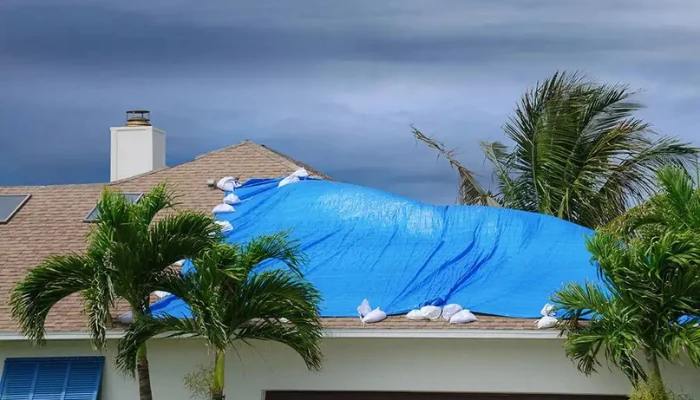Are blue tarps waterproof? It’s the first question most people ask after a storm, when they’re up on a ladder trying to cover a roof because when water starts getting in, every minute counts.
Blue tarps are some of the most used emergency covers across the U.S. According to FEMA, they’ve been part of thousands of post-disaster responses over the past decade.
Despite their popularity, many people still don’t know what blue tarps can really handle and what they can’t.
In this guide, we’ll break down exactly how waterproof blue tarps really are, how they behave under real-world conditions, and how to use them the right way, based on what we’ve seen out in the field with the team at Protect Preserve Roofing.
Don’t waste money replacing a tarp every month.
Learn what works, what fails, and how to make the most of your blue tarp before the next rain hits.
Table of Contents
ToggleWhat Does “Waterproof” Mean for Blue Tarps?
People throw the word “waterproof” around like it means bulletproof. But when it comes to tarps – especially blue ones – there’s a big difference between being water-resistant and truly waterproof. Let’s clear this up:
- Water-resistant means the tarp can handle a light rain or splash.
- Waterproof means it stops water cold—even during a full downpour or when water pools on top.
Most blue tarps fall somewhere in the middle. They start out waterproof, but only when they’re brand-new and tightly secured. Over time, heat and sunlight break the material down. Then the leaks start.
So, are blue tarps really waterproof?
Technically, yes… at first. Blue tarps are usually made from polyethylene. This material is coated to repel water.
However, here’s the catch: it doesn’t stay waterproof forever. The coating breaks down, especially under direct sunlight.
Blue tarps protect well for short jobs. They’re great in a pinch. But if you leave them outside too long, you’re gambling with the weather.
Are Blue Tarps Waterproof or Just Water-Resistant?
You grab a blue tarp, throw it over your roof or tools, and expect it to block the rain. At first, it does. But give it some time in the sun, and suddenly… it leaks.
So what’s the real deal?
Well, blue tarps start off waterproof. They’re made from polyethylene with a water-repellent coating. That coating works well at first. But the moment it’s exposed to heat, wind or strong UV rays, it starts wearing down.
And when that happens the water seeps through cracks, seams and corners like it owns the place.
Common reasons blue tarps fail:
- Sunlight damage: UV rays break down the outer layer fast.
- Pooling rain: If the tarp sags, the weight stretches the surface until it rips.
- Wind flap: Every gust loosens corners, causing wear and tear.
So when it’s no longer protection against water, it’s a warning
At Protect Preserve Roofing, we’ve seen this happen time and time again. People try to push the blue tarps beyond the limits. A week turns into three months. Then a leak. Then mold. Then real damage.
A blue tarp should be a temporary shield, not a permanent solution. If it’s been installed for more than a few weeks, it’s time to give us a call.
When a Blue Tarp Keeps Water Out and When It Fails
A blue tarp can be helpful. But only for the right job, for the right amount of time. Here’s when it holds up and when it doesn’t. Check the table for valuable information:
| Condition | Keeps Water Out? | Why It Works or Fails |
|---|---|---|
| Just installed, pulled tight | Yes | No sag, no gaps, fresh coating repels water |
| After 1–2 weeks in full sun | Starts to weaken | UV exposure breaks down polyethylene coating |
| Water pooling in center | No | Weight stretches the tarp, causes stress points and leaks |
| Flapping in wind | No | Edges wear down fast, tarp loosens and lifts |
| Secured with 2x4s, angled | Yes | Allows drainage, holds tight, prevents stress and sagging |
| Nailed through the surface | No | Holes let water in, weakens the structure immediately |
Pro tip from Protect Preserve Roofing: We see it all the time, tarps that lasted too long. If yours is flapping, sagging, or faded, it’s time to switch it out or call us for something better.
How to Test If a Blue Tarp Is Still Waterproof

Not sure if your tarp’s still doing the job? Don’t wait for the next storm to find out the hard way. Here’s how to check it with a quick test you can do at home.
Step-by-Step tarp test:
- Lay the tarp flat: Use a driveway, patio, or large open area.
- Create a slope: Place a broom or 2×4 under one end so water flows.
- Pour water slowly across the top: Use a bucket or hose.
- Check the underside: If you see drips, damp spots, or seepage, it’s not waterproof anymore.
- Check seams and edges: These are the first places that fail. Press a paper towel under the seam and wait 2 minutes.
Signs Your Tarp is Done:
- Surface feels thin or brittle
- Coating is flaking or faded
- Stitching is coming loose
- Small pinholes near folds or corners
Pro tip from Protect Preserve Roofing: If you’re not sure after the test, assume the worst. Water doesn’t wait. And neither should you
Comparison Table: Waterproof vs. Water-Resistant Tarps
Most people assume a tarp is waterproof just because it feels plastic. But the truth is, not all tarps offer the same level of protection. Here’s how they stack up:
| Tarp Type | Water Protection | UV Resistance | Lifespan in Sun | Common Use |
|---|---|---|---|---|
| Blue Poly Tarp | Short-term | Low | 3–9 months | Emergency covers, basic roof patch |
| UV-Treated Blue Tarp | Better | Medium | 6–12 months | Longer emergency use, moderate sun |
| Vinyl Tarp | Strong | High | 2–5 years | Long-term outdoor protection |
| Canvas (Untreated) | Low | Low | 6–12 months | Indoor or light outdoor use |
| Iron Horse / PVC | Excellent | Very High | 5–10 years | Permanent/semi-permanent outdoor cover |
Pro tip from Protect Preserve Roofing: A blue tarp is great when you need fast protection, but it’s not built for long-term exposure. When it’s time for a real solution, we step in. No guesswork, no leaks.
Tips to Keep Your Blue Tarp Waterproof for Longer
Blue tarps don’t last Forever, but you can stretch their life if you treat them right. Most people lose weeks of use just by skipping a few simple steps:
- Use UV-protective spray: One quick coat helps slow down sun damage. Reapply every couple of months if the tarp stays outside.
- Secure it tight: Use 2x4s, clamps, or bungee cords. Avoid ropes, they rub and wear through the plastic fast.
- Create a slope: Let water run off. Pooling water pulls the tarp down and causes stretching and leaks.
- Never nail through it: Use boards on top to hold it down. Holes = water entry points.
- Store it dry: After use, fold it flat, keep it dry, and store out of the sun. Moisture and heat together ruin tarps in storage faster than you’d think.
Pro tip from Protect Preserve Roofing: If you’re covering something important – like your roof – don’t risk it with shortcuts. We’ve seen $30 tarps destroy $3,000 ceilings.
Need help fast? We’ve got you covered literally.
Conclusion: Real Field Advice From Protect Preserve Roofing
Blue tarps have a job. And they do it well… for a while.
They’re affordable, easy to use, and perfect when time is tight. But after a few weeks in the sun or a couple of storms, even the best blue tarp starts to wear down. And once it fails, water doesn’t just get in, it causes damage fast.
That’s where we come in.
Why call Protect Preserve Roofing?
We know how long a blue tarp actually lasts because we’ve tested them in real storms.
- We’ve seen what happens when they’re pushed too far.
- We don’t guess. We secure your home with safe, proven methods.
Whether you need a tarp for one night or a long-term fix that actually holds up, we’re ready to help.
Don’t wait for leaks, mold, or damage. Contact Protect Preserve Roofing today for a quick and honest estimate.
We can schedule an appointment to examine your roof. You can get a quick estimate or you can call us.
Frequently Asked Questions
How waterproof are blue tarps, really?Brand new, they do block water. But most lose that protection within a few weeks if exposed to heat and sun every day.Are all blue tarps the same?Not even close. Some are ultra-thin, others are reinforced and UV-treated. Always check the thickness and if it says “UV-resistant.”Can I leave a blue tarp up for months?You can—but you probably shouldn’t. After a month or two, the coating starts to break down. After that, leaks are just a matter of time.How do I know when a tarp needs to be replaced?If it’s faded, brittle, flapping in the wind, or starting to leak—you’ve already waited too long. Better to replace it before the next storm.What’s the best way to secure a tarp to keep it waterproof?Use 2×4 boards or ratchet straps to hold it tight. Never nail directly through the tarp. And always create a slope so water runs off.










